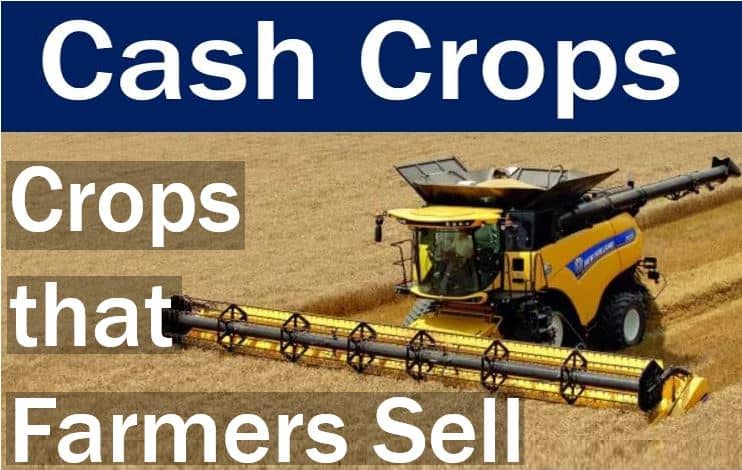A Cash Crop is a crop that farmers grow for profit. In other words, their aim is to sell the harvest in exchange for money, rather than use it for subsistence. A subsistence crop is there to feed the farmer and family members.
We use the term ‘cash crops’ for plants, but not for livestock, i.e., cattle, poultry, sheep, etc.
Apart from large farms and subsistence plots, there are also market gardens. These are small plots of land. Market gardeners sell their crops for profit.
Farming practices in much of the world today are different to what they used to be. In most advanced economies, cash crops historically represented a small part of a farm’s total production.
However, this changed at the end of the last century. Today it is the other way round; farmers sell most of their crops for revenue.
Low-income nations export most of their cash crops to the advanced economies. However, subsistence farming still exists in low-income countries. Subsistence farming refers to farmers growing crops to feed themselves.
The international commodity markets set the prices for most cash crops. There is some price variation due to local demand, supply, and transportation costs.

Cash crops are crops that farmers sell. This type of farming contrasts with subsistence farming. In subsistence farming, the farmers do not sell the crops – they eat them.
Farmers worldwide are at the mercy of global commodity prices. The farmers thrive when demand is high, and supply is comparatively low. However, they suffer when there is a glut and prices plummet.
Cash crop dilemma
Farmers in developing nations say it is virtually impossible to compete against the advanced economies because governments subsidize their cash crops.
Many economists say these subsidies have contributed to the deterioration of agriculture in countries like Mexico.
Millions of Mexican farmers abandoned the land and moved to urban areas. In fact, many of them crossed the border into the United States looking for work.
Jayati Ghosh wrote in the Guardian that agricultural subsidies affect the livelihoods and food security of millions of people. Agricultural subsidies harm the lives of more than 50% of the world’s population.
Cash crops – regions
Tropics
In the tropics, farmers grow jute, cotton, oranges, sugar cane, cocoa, coffee, and palms (mainly oil palm). They also grow mangoes, bananas, papaya, and other tropical fruit.
Subtropics
This region may include some of the plants grown in tropical areas, plus grain crops. For example, millet, rice, and oil-yielding crops (soybeans). Farmers also grow some types of herbs and vegetables.
Temperate
In temperate regions, oats, wheat, corn, rye, and barley are common. Farmers also grow vegetables and several types of fruit. Examples of fruits include apples, pears, cherries, strawberries, raspberries, and blueberries.
Did you know? – In order to increase cash/revenue from a corn crop you need to understand various corn growth stages. if you are thinking that the corn ear was dutifully named for its resemblance to human ears in the way that individual corn cobs stick off a stalk, you would be incorrect. It seems like a reasonable leap, but the naming of corn as ears is actually much more linguistic in its basis.

Arctic
The Arctic is inhospitable for most agricultural products. One potential cash crop might be Rhodiola rosea (golden root or rose root). It grows in the cold regions of the world, including the Arctic.
According to some studies, golden root may have an antidepressant effect. Demand currently exceeds supply for this perennial flowering plant.
Amidst the growing market for alternative natural remedies, Arctic farmers are exploring the cultivation of Rhodiola rosea to meet the global demand.
Example Sentences
Below, you will find several example sentences containing the term “cash crops,” illustrating how we use this term in different contexts:
- “The farmers in the region have started to consider lavender as a potential cash crop due to its high market value.”
- “Once primarily a subsistence farmer, he now grows coffee as his main cash crop and has seen a significant increase in his income.”
- “In the 18th century, tobacco was the dominant cash crop of the southern colonies, shaping their economy and society.”
- “The introduction of quinoa as a cash crop has changed the agricultural landscape of the Andean highlands.”
- “She realized that diversifying her cash crops could help insulate her farm from market fluctuations.”
- “While cotton remains a major cash crop, farmers are increasingly turning to less water-intensive alternatives to meet sustainability goals.”
Video explanation
This video explains what ‘Cash Crop’ means using simple and easy-to-understand language and examples.
